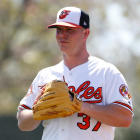
2017 Fantasy Baseball draft strategy: Can Dylan Bundy still cut it as an ace?
The former top prospect showed flashes of brilliance last season. Chris Towers looks closer at what he might need to sustain it.

The Orioles aren’t likely to have great pitching this season. They finished just 17th in baseball in runs allowed in 2016, and with a 19th-place finish in FIP, it’s hard to argue that it was just the defense letting them down.
So, this might not be the best place to go searching for aces, right? Not if you want sure things. Go look to the Nationals or Cubs if you want sure things. Me? I’m not looking for “sure things,” because I don’t believe there’s any such thing at starting pitcher. And, where relatively safe options do exist, they tend to come with huge price tags that I’m not willing to pay.
So, I have to settle for the Orioles of the world. I already detailed why Kevin Gausman could be one small change away from taking a big step forward, and it is a sound argument. Gausman has already showed the potential for big things in the majors, and could have started his breakout in the second half of the season.
The argument for Dylan Bundy isn’t quite as easy to make. He and Gausman spent a lot of time together at the top of Orioles’ prospect lists about five years ago, however, while Gausman has 453 innings over parts of four seasons in the majors under his belt, Bundy was forced on to the major-league roster after running out of options, and has thrown just 111 1/3 innings in the majors. The vast majority of those innings came in 2016, when he posted a 4.02 ERA for the Orioles in 36 appearances -- 14 starts.
In a vacuum, Bundy’s performance last season wasn’t super promising. He was right around average in strikeout rate, at 21.9 percent, and walked more batters than average, at 8.9 percent. He gave up a ton of flyballs as well, and unsurprisingly struggled keeping the ball in the yard while pitching half his games in Camden Yards. However, considering Bundy has thrown just 63 1/3 innings since 2012, that isn’t a bad re-introduction to competitive baseball.
Bundy obviously needs to pitch better than he did in 2016 to justify any kind of hype, and you’re going to be doing a lot of wishing with him. With an ADP of 263, there isn’t much downside there, but if the hype starts to grow, Bundy could become the kind of risk you can’t afford to take.
However, there are reasons to think Bundy isn’t even being hyped enough. He just may well be the most ideal post-hype prospect ever. Once considered one of the best pitching prospects of the decade, Bundy managed to hold his own under pretty difficult circumstances last season. Circumstances that look even more thorny when you consider that Bundy wasn’t even allowed to throw his best pitch.
Last season, Bundy got by largely on a three-pitch combination. He threw his fastball about 60 percent of the time, and supplemented that with roughly equal parts of his changeup and curveball. He had above averaged swinging strike rates on both his four-seam fastball and his changeup, but had trouble keeping both pitches in the yard. His curveball wasn’t much of a swing-and-miss pitch, but opposing hitters had just an .017 ISO against it. There is something to like about all three pitches, but adding in his struggles the third time through the lineup, Bundy certainly seems like he could use another pitch.
Of course, coming up as a prospect, Bundy’s cutter/slider wasn’t just “another pitch.” It was his bread winner, routinely graded out as a top-flight pitch. Bundy abandoned it after his seemingly endless bout of injuries, and the Orioles have reportedly had organizational debates about whether to allow him to throw it. He has been throwing it, and the reviews have been promising. According to Jon Heyman of FanRagSports.com, Chris Davis came away from a batting practice session against Bundy blown away by the pitch.
It is worth noting at this point, Bundy’s results in the spring haven’t been uniformly great. However, if Bundy is going to take that big step forward, it seems likely he will need a more reliable go-to pitch. If the cutter/slider can be that, Bundy’s ceiling looks quite a bit higher.
Bundy might be the ultimate wild card of this year’s pitching crop, because we haven’t seen much more than flashes of his potential since 2012. On the other hand, some considered him a potential major-league arm at 18, and he rocketed through the minors with a 2.08 ERA and 29.9 percent strikeout rate in 2012, reaching the majors for a cup of coffee as a 19-year-old.
He may never reach that potential. If you’re the betting type, I might even say you should put your money on that assumption. However, I’m willing to hedge that bet. The investment in Bundy right now is still small enough that the payoff can still very much be worth it.


















